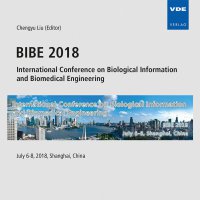Optimization of oxygen mass transfer in a bio-artificial liver support system based on an oxygen carrier
Konferenz: BIBE 2018 - International Conference on Biological Information and Biomedical Engineering
06.06.2018 - 08.06.2018 in Shanghai, China
Tagungsband: BIBE 2018
Seiten: 4Sprache: EnglischTyp: PDF
Persönliche VDE-Mitglieder erhalten auf diesen Artikel 10% Rabatt
Autoren:
Wu, Changzhe; Huo, Xiaolin (Beijing Key Laboratory of Bioelectromagnetism, Institute of Electrical Engineering, Chinese Academy of Sciences, No. 6 Beiertiao, Zhongguancun, Beijing, 100190, China & University of Chinese Academy of Sciences, Beijing, 100049, China)
Zhang, Cheng; Zhang, Guanghao (Beijing Key Laboratory of Bioelectromagnetism, Institute of Electrical Engineering, Chinese Academy of Sciences, No. 6 Beiertiao, Zhongguancun, Beijing, 100190, China)
Inhalt:
This study demonstrates that providing an appropriate dissolved oxygen concentration (DO), pH, and temperature for hepatocytes in a bioreactor improves the performance of bio-artificial liver support systems (BALSS) based on a high density hepatocyte culture. Among the above parameters, the DO is the most important and difficult to control. To improve the hypoxia environment, an oxygen carrier was introduced to enhance the oxygenation in the bioreactor. The intended purpose is to enhance hepatocyte growth and functionality in a BALSS. In this paper, the demand of oxygen carriers and the oxygenation rate after the adjustment of inlet velocity, the oxygen pressure, and other parameters were studied through experimentation. When the volume of the bioreactor is 500ml, the volume fraction of the oxygen carrier is 30%, the oxygen source pressure is 0.1 MPa and the flow rate of culture medium is above 120 mL/min, the oxygen demand of high density cultured cells can be satisfied. The introduction of perfluorocarbon oxygen carriers significantly improves the oxygenation efficiency of bioreactors, and effectively promotes the practical application of high density cultures in vitro and in the bioartificial liver.


